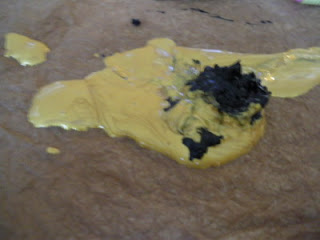Once I figured out how to heat emboss successfully (I took a class), I really loved it! My article today is where I started looking at the world through powdery eyes!
I am going to show several projects, each with a different "outside the box" technique. I now label my particular brand of embossing as "freeform embossing" and that means anything goes! (Note: For all embossing I used Versamark)
1. Gilded
The main punch to this card is the background. It is gold embossed onto black linen card stock and matted onto gold foil paper which is layered onto a black A2 card base.
The Embossing:
- Background:
- I took my versamark pad and swiped the edge of it at an angle across my card stock (5 x 3 3/4 inches). I used fine gold embossing powder and heated with a heat gun.
- Flowers:
- I took paper flowers and dabbed each one against the versamark pad. (I rolled the tulips on their sides on the pad also.) I then held the flower by its wire stem and dipped it into the gold embossing powder. I heat embossed all fowers one at a time so that I could carefully monitor each flower to assure it didn't burn. There was no problem at all. I would be very careful about trying this with fabric flowers as the fabric may have a lower melting temperature if the fabric is faux.
- Cameo:
- I was going to emboss the cameo a little to enhance the face. I decided not to. If I had I would have dabbed the cameo onto the pad and used a paint brush with some versamark ink on it to add some highlights to the edges.
2. For Thought
There are actually two kinds of embossing here.
The Hours:
If you look at the queen above, she is gazing at a white metal flower inside a cicrle of roman numerals. The numerals are embossed with clear embossing powder.
I think sometimes this method can be a little forgotten. I know I do because I like to use gold so much.
The trick to embossing with clear embossing powder is using colored ink that will not dry too quickly. Distress ink is really good for this, especially now that they have some really vivid colors added to the line.
Stamp your image onto your paper with colored ink. Cover with clear embossing powder and heat emboss. What always thrills me is when the clear embossing powder starts to melt and reveals the beautiful color underneath!
3. Muse
There are technically two kinds of embossing in this card: dry embossing (the yellow background) and the gold lines on the tag (heat embossing).
My experiment:
I used a piece of card stock (white) and covered that with CROCO in Copper. This paint works similarly to the Crackle paint that Range sells. I happened to want to try this brand out so I used it on this project. I helped out the cracking with my heat gun. Once dry, I took a Versamark pen and started tracing the cracks. I added gold embossing powder. I was able to brush away the excess powder (there was a lot) using a foam brush. The powder that remained was in the cracks. I heat embossed the powder until it melted.
Things to remember: The embossing powder was a little thicker in this porject and took longer to melt so I had to be really careful with the crackle paint beneath. I did end up with a couple of bubbles which I thought added to my piece.
I started with an A2 sized piece of card stock. Once everything was dry, I cut out my tag choosing the section that most appealed to me.
4. Miss You
My last card uses nature as the tool to create some beautiful textures and images on my card. I went outside and pulled off a couple leaves (one large and one small-I didn't use the small one on this project but you can see the other card I made using the small leaf on my blog:
www.madeforpaper.blogspot.com). I also decided to use a piece of branch from a tree (The image is in silver below).
I used my VersaMark pad and did some test embossing first to decide which side of the leaf I wanted to use to get the best image. I used the back side. Then I coated the back of the leaf with VersaMark ink and pressed it gently onto my paper. I learned that if I press with my fingers I get a fingerprint image also. I tried a papertowel folded up which worked well. I was worried about getting the ink on my fingers (you know what happens when you then handle the paper) so I was very careful - but in the end I had to use my hands.
Close Up!
I started by applying the fir tree image across the bottom of my paper and then embossing in silver. Then I embossed my leaves in gold. The gold is overembossed (my term) onto the silver.
Here is another good look at the leaves. Didn't they turn out good? (Although I wish that I could have gotten more veining to come through. Next time I will choose a more veined leaf.)
I hope that you enjoyed our little journey through some embossing techniques and that you will try some of these in your art!
Lis



























